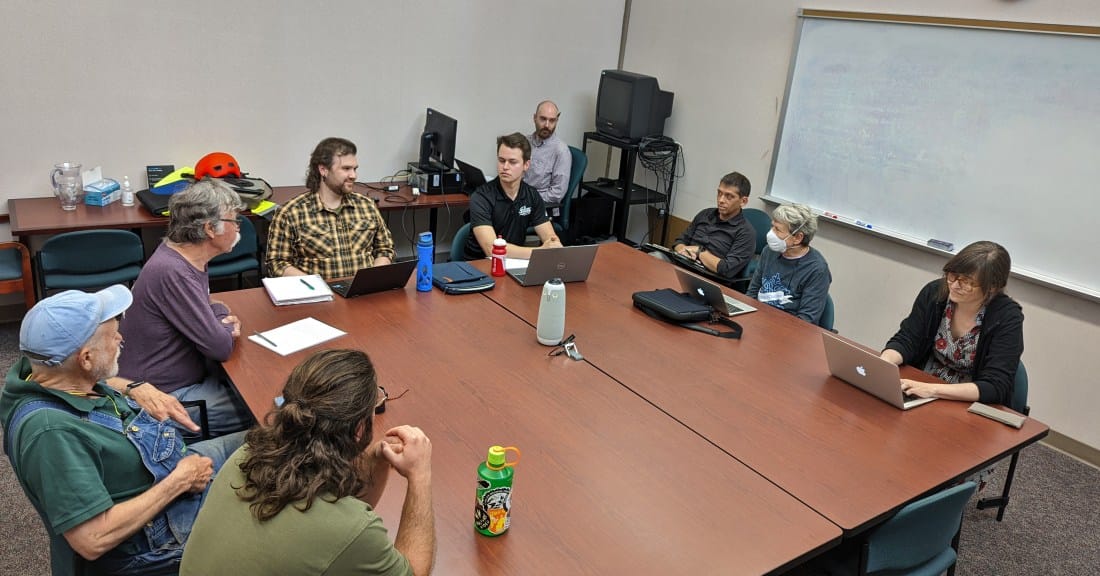Bike-ped group advises against direct oversight of traffic calming projects by Bloomington city council


On a unanimous vote of its seven members on Monday night, Bloomington’s bicycle and pedestrian safety commission (BPSC) recommended that the city council not adopt an ordinance that would establish the council as the decision maker on traffic calming and greenway projects.
The ordinance appears on the city council’s Wednesday (May 10) meeting agenda.
The council had postponed consideration of the law at its meeting last week, specifically in order to give the BPSC a chance to weigh in on the latest version of the ordinance.
A different version had been introduced by councilmember Dave Rollo in November last year, and got some discussion by the council at a Nov. 30, 2022 committee-of-the-whole meeting.
This latest version of the ordinance keeps the provision that adds a required city council approval to all traffic calming and greenway projects. The more recent version abandons a proposed change to the percentage of “affected housing units,” who have to give their signatures in support. The threshold is 30 percent. The earlier version of Rollo’s ordinance had proposed to increase the threshold to 50 percent.
Rollo’s proposed ordinance can be analyzed as a partial repeal of an ordinance enacted in October 2020 [Ord 20-17]—which removed city council approval as a requirement for installation of traffic calming and greenway projects, and reduced the signature threshold from 50 to 30 percent.
The October 2020 ordinance also re-titled the program from Neighborhood Traffic Safety Program (NTSP), which was enacted in 1999, to the Traffic Calming and Greenways Program (TCGP).
Given that city council approval of projects was previously a part of the NTSP, Rollo’s proposed ordinance could be described by its supporters as a restoration of the oversight of traffic calming projects that the city council exercised in the past.
Rollo’s ordinance could be described by its detractors as a reversal of the progress towards de-politicization of traffic calming decisions that was made with the enactment of Ord 20-17 in late 2020.
At Monday’s BPSC meeting, commissioner Mitch Rice described the proposal as giving the city council a “veto” over a process that would come at a late stage—for both citizen-led and staff-led projects. Rice said, “Putting a political stamp on the end of the process seems to be incorrect to me. If politics has to have a hand in a citizen-led project, it seems to me citizens are the political side.”
Echoing Rice’s sentiment during public comment on Monday was Bloomington resident and former member of the BPSC Mark Stosberg, who cited his equity analysis on sidewalk funding, which he did in late 2020.
Stosberg said, “One of the findings there was that equity is improved when we use an objective process to fund sidewalks. And one of the things that is not good for equity is then to have a political mechanism to override the process at the end, which sounds like what the council is proposing here.”
Weighing in during public comment in favor of the council’s required approval was Bloomington resident Eric Ost, who sees the city council’s involvement in decision making not as a political intrusion, but as elevating the decision making process for greater public participation.
Ost said, “In truth, the common council and its being involved can..focus attention that enables project improvements.” Ost added, “[Council involvement] can advance funding allocation opportunities, and it can convene by its very nature, enhanced democratic opportunities for greater public inclusion and involvement.”
BPSC member Pauly Tarricone traced the origins of Rollo’s proposed ordinance to the staff-led Hawthorne and Weatherstone neighborhood greenway project, which generated considerable opposition from residents who live in the neighborhood. Rollo’s city council district includes the area.
Tarricone noted that under the current Traffic Calming and Greenways Program, enacted in 2020, the approval from the BPSC is still required.
Tarricone said, “I think it’s important to note that we are not necessarily a rubber stamp for the city’s recommendations. He added that not all BPSC members are in agreement about how the Hawthorne and Weatherstone greenway should be implemented— or even if it should be implemented
Tarricone concluded that the step of adding council approval is “more than redundant” given the number of public meetings that are held in advance of the decision. Requiring city council approval just adds barriers, Tarricone said, “especially for people who are already dealing with a lot of unsafe conditions for riding and walking, the places in Bloomington.”
BPSC member Ann Edmonds noted that while the Hawthorne and Weatherstone project has met opposition, there are some projects that people are “begging for.” Edmonds said that residents wanted a better crossing at Weatherstone Lane and Hillside Drive, but the city’s assistant transportation director Beth Rosenbarger had to say “over and over again at public meetings” that the proposed greenway project does not include that intersection.
The Hawthorne and Weatherstone greenway project was the subject of one of the specific Tweets posted last year by traffic commissioner Greg Alexander, which led to Rollo’s attempt, now apparently abandoned, to have the city council remove Alexander from the traffic commission.
During public commentary at Monday’s BPSC meeting, Alexander weighed in against Rollo’s proposed ordinance. Alexander said, “Every successful Vision Zero plan has a component that’s like our greenways program—sometimes, it’s called low-traffic neighborhoods, quiet streets, or bike boulevards.” Having watched Bloomington’s greenways program for 15 years, Alexander called it “disappointing, very timid, very slow moving.”
About the city’s greenways program, Alexander said, “It is finally picking up steam just in the past three years. And now the council wants to slow it down again, because some people oppose speed humps.”
Rollo’s ordinance appears on the city council’s 6:30 p.m. Wednesday (May 10) meeting agenda for possible final enactment.




Comments ()